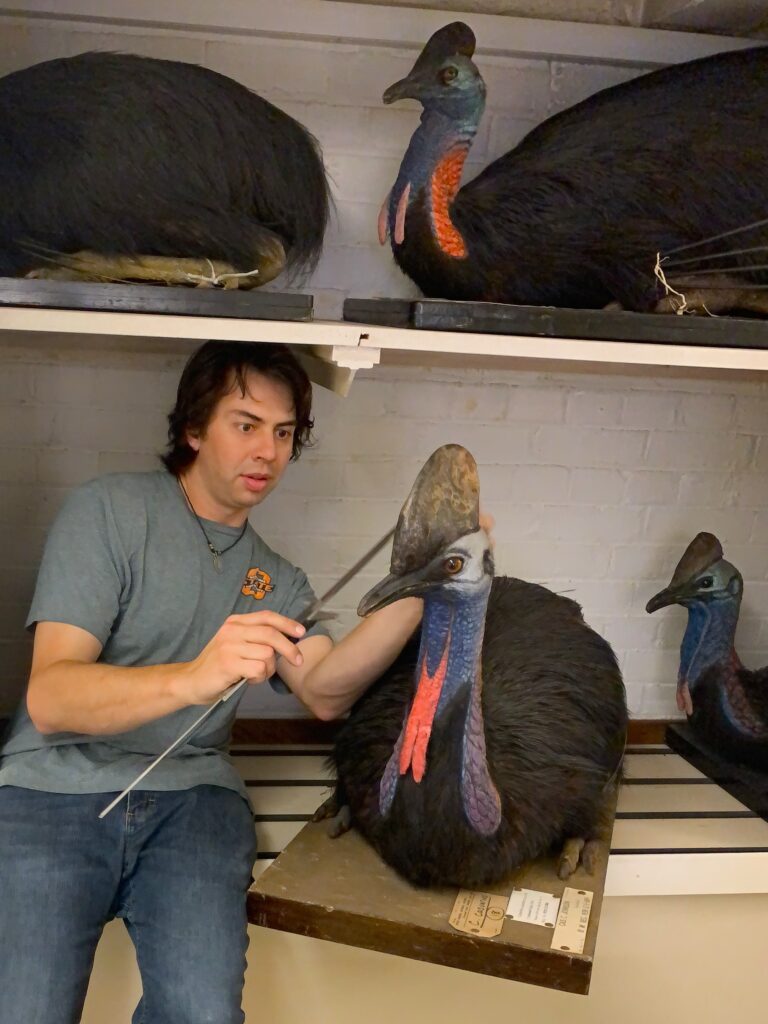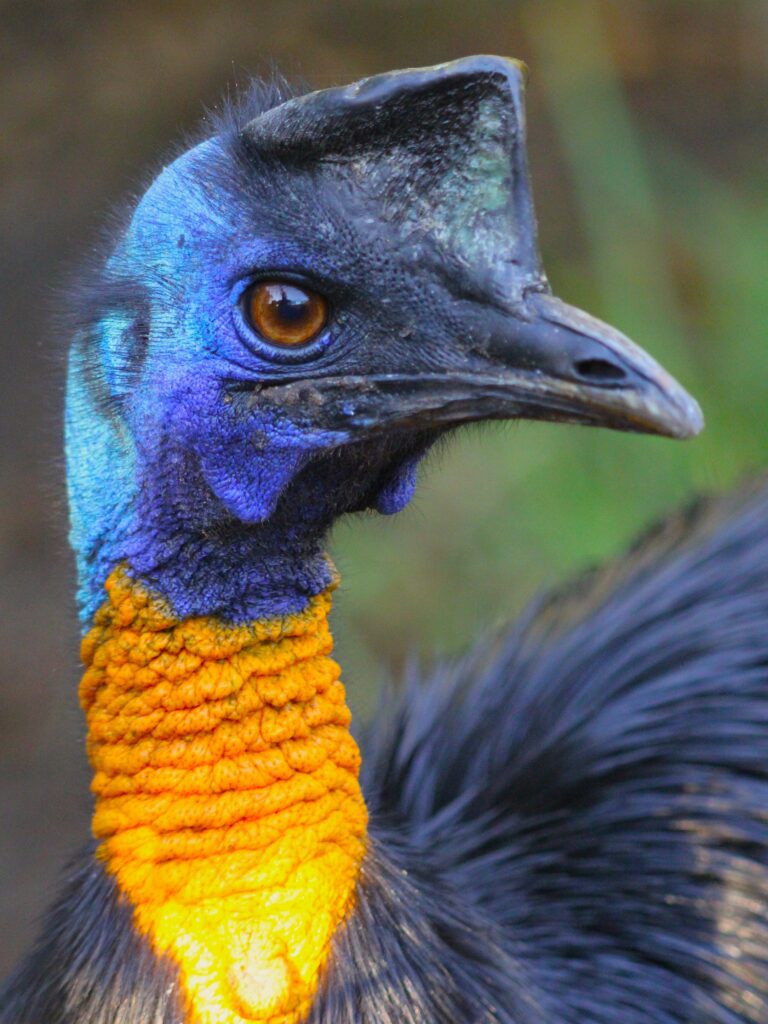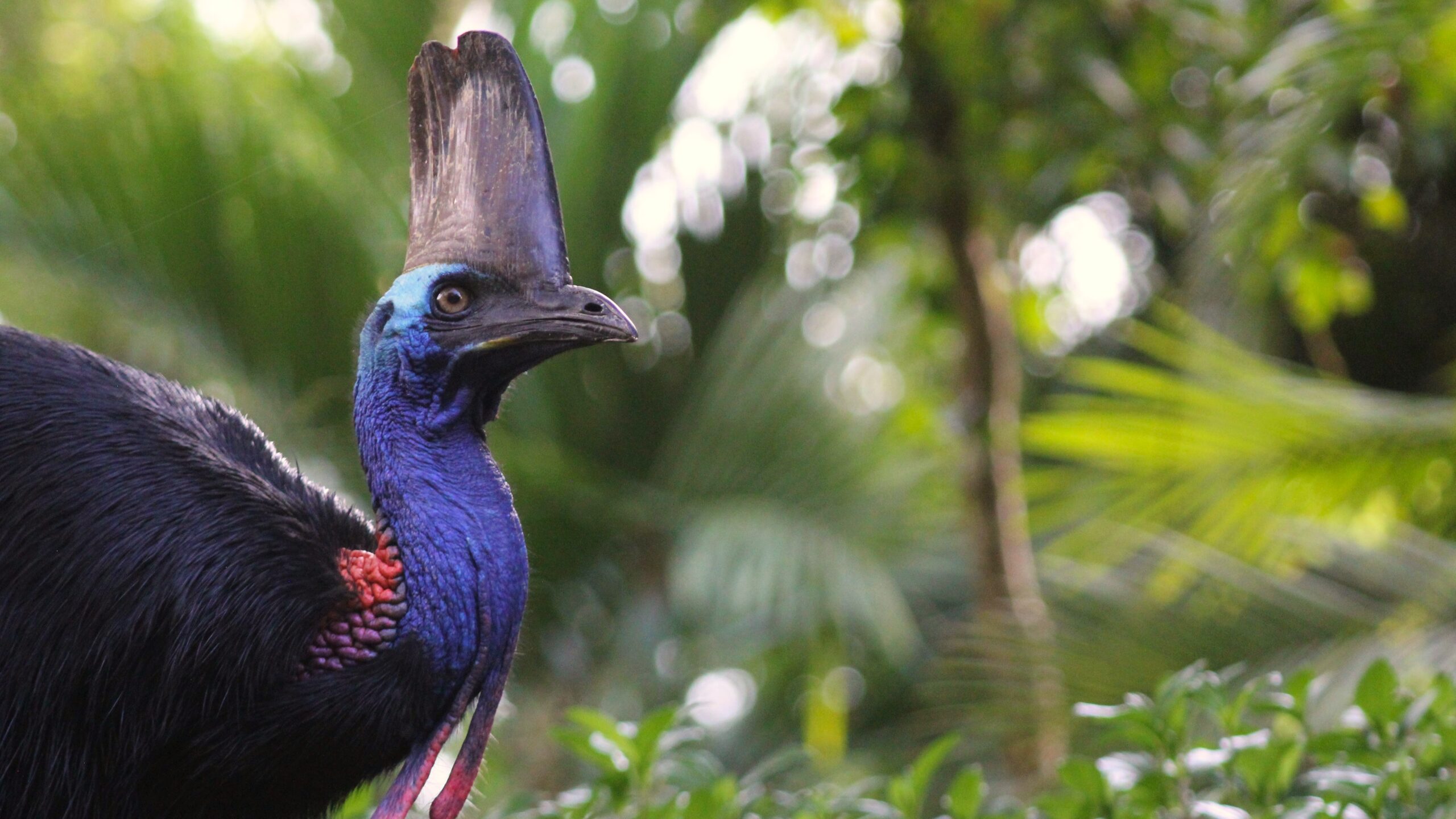By Todd L. Green, Ph.D., New York Institute of Technology College of Osteopathic Medicine at Arkansas State University, Department of Biomedical and Anatomical Sciences
Related paper: Species-specific casque shapes in the genus Casuarius and implications for visual display by Todd L. Green, David I. Kay, Aki Watanabe, and Paul M. Gignac, Ornithology
A Bird of a Different Feather
The irony of writing a story about 45-kilogram cassowaries—with forelimbs as small as those of chickens—for a blog called Wing Beat is not lost upon me. My coauthors and I are particularly excited to publish a paper for Ornithology about these flightless birds, as it seems most of the researched avian species in this journal are no larger than a mango. I first became fascinated with cassowaries as a child, due to their outward similarities to extinct dinosaurs. Now, as a paleontologist, I focus on deciphering the functional anatomy and evolutionary history of one of those features, their cranial casques, to better compare to and interpret the head ornaments of non-avian dinosaurs.
Curious Casques
For more than 150 years, the conspicuous cranial casque has been acclaimed as the most iconic feature of cassowaries—perhaps, in addition to the lethal daggers adorning their inner toes. Today, many researchers suggest that the casque may serve a role in visual signaling to other cassowaries, perhaps for territorial disputes, assessment of maturity, or even recognition of species. To better understand the third concept, we decided to assess whether the shapes of cassowary casques are unique between the three living species: Casuarius bennetti (Dwarf Cassowary), Casuarius casuarius (Southern Cassowary), and Casuarius unappendiculatus (Northern Cassowary).
Fieldwork of Dreams

Data collection for this study was thrilling for a self-proclaimed cassowary enthusiast. Analyzing 155 bird specimens led me to legendary scientific locations worldwide, from the American Museum of Natural History in New York City to Lord Walter Rothschild’s collection at the Natural History Museum at Tring. I visited Australian museums filled with flightless birds and the Wet Tropics of Queensland, where I observed living cassowaries in the wild. Photographing these formidable birds without a safety fence was exhilarating and allowed us to determine differences in casque shape by digitally tracing casque outlines. I was fortunate to work with two talented individuals who are well versed in writing complex code for shape analyses, Drs. David Ian Kay and Aki Watanabe.
Cassowaries as Time Machines
Our results revealed that average casque shapes are quantitatively different between adult cassowary species. The casques of Dwarf Cassowary and Southern Cassowary are particularly unique, and Northern Cassowary casques share some shape characteristics with the other two. So, why is this important? Well, we know relatively little about how cassowary casques evolved. But this mystery extends far beyond modern birds. The fossil record is replete with animals sporting head gear that paleontologists struggle to interpret. Did Carnotaurus’s devil-like horns serve the same function as a cassowary’s casque? What about the towering nasal crests of hadrosaurs?
The challenge with extinct species is that we can observe their anatomy in exquisite detail, but we can never watch them use these ornaments in life. This is where cassowaries become invaluable. As one of the few large, modern dinosaurs with prominent cranial ornamentation, they offer a rare window into how such structures might have functioned. If we can demonstrate that cassowary casques serve as species recognition signals today, it strengthens the case that similar ornaments in dinosaurs may have served comparable roles millions of years ago.
However, before we can make any assessments about how behavior, biogeography, and ecology may have helped shape these changes, we must first attain a strong anatomical foundation, which has been an ongoing theme in my research.
Stretch Your Interpretations

My colleague and former Ph.D. advisor, Dr. Paul Gignac, and I have long discussed evolutionary processes shaping cassowary morphological changes. Due to their poor fossil record, some ideas are speculative until more data is compiled. What we do know is that cassowaries are territorial animals that become violent if competitors don’t retreat. They engage in a ritualized “stretch display” where they elongate their bodies and necks skyward, displaying their casques. Other bird species also exhibit stretch displays, but perceived height may deter dangerous clashes between these large birds in particular, favoring their cranial ornamentation as a height enhancer. As cassowary populations isolated and speciated due to sea level rises between mainland Australia and New Guinea, casque morphologies may have changed. As levels subsided and populations reencountered, casque shape may have helped individuals identify their populations, explaining reproductive barriers and maintaining species boundaries in shared islands like Papua New Guinea. Our data supports this scenario as a possible casque function.
Due to their temperament, remoteness, and rarity, cassowaries are not the easiest animals to study. Nonetheless, they may be the best-suited modern analog for understanding the cranial ornaments of long-extinct dinosaurs. In addition, we hope to gain a thorough understanding of the life history of these endangered cassowaries to aid in their continued conservation management.
